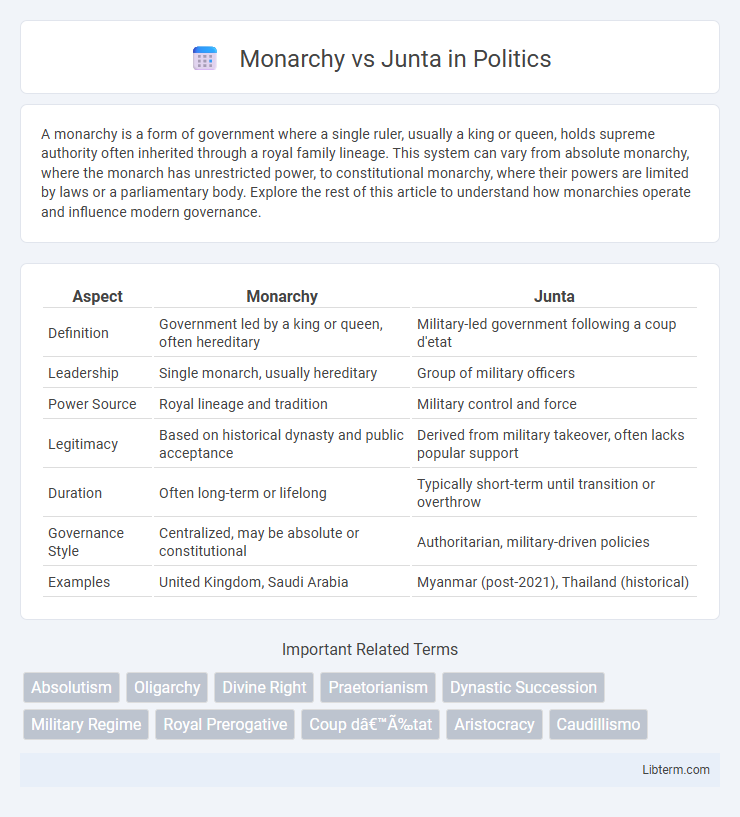A monarchy is a form of government where a single ruler, usually a king or queen, holds supreme authority often inherited through a royal family lineage. This system can vary from absolute monarchy, where the monarch has unrestricted power, to constitutional monarchy, where their powers are limited by laws or a parliamentary body. Explore the rest of this article to understand how monarchies operate and influence modern governance.
Table of Comparison
| Aspect | Monarchy | Junta |
|---|---|---|
| Definition | Government led by a king or queen, often hereditary | Military-led government following a coup d'etat |
| Leadership | Single monarch, usually hereditary | Group of military officers |
| Power Source | Royal lineage and tradition | Military control and force |
| Legitimacy | Based on historical dynasty and public acceptance | Derived from military takeover, often lacks popular support |
| Duration | Often long-term or lifelong | Typically short-term until transition or overthrow |
| Governance Style | Centralized, may be absolute or constitutional | Authoritarian, military-driven policies |
| Examples | United Kingdom, Saudi Arabia | Myanmar (post-2021), Thailand (historical) |
Introduction: Understanding Monarchy and Junta
A monarchy is a form of government where a single ruler, usually a king or queen, holds supreme authority often inherited through a royal family lineage. In contrast, a junta is a government led by a small group of military officers who seize power, typically through a coup d'etat, bypassing traditional democratic processes. Both systems centralize power but differ fundamentally in legitimacy, leadership structure, and political dynamics.
Historical Origins of Monarchies and Military Juntas
Monarchies originated in ancient civilizations where kingship was often legitimized by divine right, evolving through dynastic succession and centralized hereditary rule. Military juntas emerged primarily in the 20th century as governments led by armed forces seized control through coups d'etat, often during political instability or post-colonial transitions. Monarchies emphasize lineage and tradition, while juntas are characterized by temporary, authoritarian military control and the suspension of civilian governance.
Key Characteristics of Monarchies
Monarchies are characterized by a hereditary system where a king, queen, or emperor holds supreme authority, often symbolizing national unity and continuity. This governance structure relies on dynastic succession, centralized power, and formal protocols that legitimize the ruler's authority through tradition and cultural heritage. Unlike juntas, monarchies typically emphasize stability, ceremonial roles, and institutionalized legal frameworks that maintain order and reinforce the ruling family's legitimacy.
Fundamental Features of Military Juntas
Military juntas are authoritarian regimes where power is concentrated in a group of high-ranking military officers who control the government through force and lack civilian oversight. These regimes typically suspend constitutional processes, impose strict censorship, and restrict political freedoms to maintain control and suppress opposition. Unlike monarchies, which are often hereditary and symbolic, military juntas rely on coercion, hierarchy within the armed forces, and a command structure that enforces discipline and obedience.
Governance Structures: Monarchic vs Junta Rule
Monarchy centralizes authority in a hereditary ruler who governs with established traditions and often a codified legal framework, ensuring political continuity and stability. Junta rule consists of a group of military officers seizing power, imposing direct control through authoritarian measures, frequently bypassing legal institutions and civilian oversight. Governance under monarchy emphasizes legitimacy through lineage and ritual, while junta governance relies on military dominance and force for political control.
Power Succession: Heredity vs Military Seizure
Power succession in monarchies is typically hereditary, passing authority through family lineage to maintain stability and continuity within the ruling dynasty. In contrast, juntas acquire power through military seizure, often resulting in abrupt regime changes driven by force rather than established succession laws. This fundamental difference impacts governance legitimacy and political stability, with hereditary succession promoting long-term planning and military coups frequently leading to instability.
Public Participation and Civil Liberties
Monarchies often limit public participation in governance, concentrating power within a royal family, which can restrict civil liberties due to centralized, hereditary authority. Juntas, typically military-led regimes, impose strict controls on civil liberties while sidelining democratic institutions, resulting in minimal or coerced public involvement. Both systems suppress broad political engagement, but juntas frequently enforce harsher restrictions on freedom of speech and assembly compared to traditional monarchies.
Stability and Longevity of Rule
Monarchies often achieve long-term stability through established hereditary succession, which promotes continuity and minimizes abrupt political upheavals. Juntas, typically composed of military leaders, may establish control quickly but often struggle with internal power struggles and lack institutional legitimacy, leading to shorter rule durations. Historical data shows monarchies generally sustain governance for centuries, while juntas frequently last only a few years before facing coups or transitions.
Economic Impacts: Monarchies Compared to Juntas
Monarchies often provide economic stability through long-term policies and centralized decision-making, attracting foreign investment and fostering tourism linked to royal heritage. Juntas typically cause economic uncertainty due to unpredictable governance, frequent policy shifts, and potential sanctions or international isolation. Comparative analysis shows monarchies maintain higher GDP growth rates and lower inflation than juntas, which frequently experience capital flight and suppressed markets.
Modern-Day Examples and Global Perspectives
Modern-day monarchies like Saudi Arabia and Jordan maintain centralized power through hereditary rule, emphasizing tradition and stability within constitutional or absolute frameworks. In contrast, contemporary juntas such as Myanmar's military regime exert control via armed forces, often following coups that suspend democratic institutions and limit civil liberties. Globally, monarchies typically embody symbolic or ceremonial roles with varying degrees of political influence, whereas juntas prioritize military dominance, frequently drawing international condemnation and sanctions for undermining democratic governance.
Monarchy Infographic

 libterm.com
libterm.com